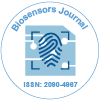Research Article
Biosensors for Indirect Monitoring of Foodborne Bacteria
Diana C Vanegas1, Carmen Gomes2* and Eric S McLamore3
1Food Engineering, Universidad del Valle, Colombia
2Biological and Agricultural Engineering, Texas A&M University, USA
3Agricultural and Biological Engineering, University of Florida, USA
- *Corresponding Author:
- Carmen Gomes
Biological and Agricultural Engineering
Texas A&M University, USA
Tel: 979845-2455
E-mail: carmen@tamu.edu
Received date: March 05, 2016; Accepted date: May 04, 2016; Published date: May 05, 2016
Citation: Vanegas DC, Gomes C, McLamore ES (2016) Biosensors for Indirect Monitoring of Foodborne Bacteria. Biosens J 5: 137. doi:10.4172/2090- 4967.1000137
Copyright: © 2016 Vanegas DC, et al. This is an open-access article distributed under the terms of the Creative Commons Attribution License, which permits unrestricted use, distribution, and reproduction in any medium, provided the original author and source are credited.
Abstract
Microbiological safety assessment in food samples is often a cumbersome and time consuming task that has to be done in a regular basis in most food manufacturing facilities. Standard microbiological techniques for evaluating critical levels of bacteria take several days to yield results, thus the food products have to be withheld in the processing factories until the safety inspection is concluded. The food industry requires faster and reliable tools for more efficient microbiological testing that can reduce the safety inspection lag significantly. Biosensors that target specific molecules associated with bacterial activity are amongst the most promising technologies for addressing this need. State-ofthe- art biosensors allow for instantaneous quantification of molecular biomarkers. This review focuses on describing the operation mechanism and technological challenges and opportunities for developing high performance biosensors capable of real-time monitoring of biomarkers from foodborne bacteria.

 Spanish
Spanish  Chinese
Chinese  Russian
Russian  German
German  French
French  Japanese
Japanese  Portuguese
Portuguese  Hindi
Hindi